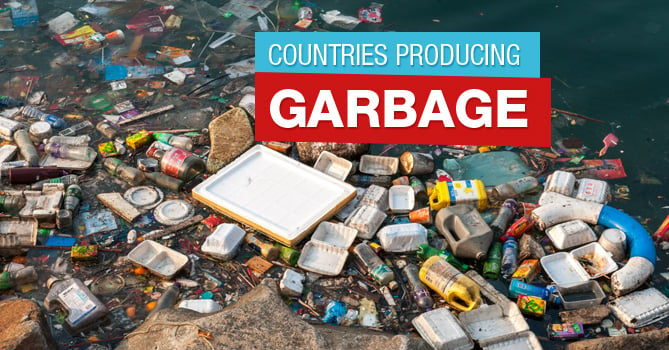Municipal Solid Waste (MSW) has emerged as a serious global concern with direct impact on human health and environment. The definition of municipal solid waste differs as countries classify according to their own interpretation. As per World Bank, it includes all non-hazardous waste generated from residences, commercial businesses and institutions, along with non-hazardous industrial waste, agricultural waste produce, and sludge produced from sewage.
Type of wastes
Domestic waste generated from households include food waste, fabric, wood, leather, paper, plastics, glass, metals, items like used batteries, white goods, electronics etc. Hazardous materials from households include cleaning agents, acids, mercury, paints etc.
Industrial waste includes chemicals, packaging, metals, special wastes, e-waste, combustion waste, construction material etc.
Commercial business waste include food waste, packaging material, cans and metals, fabric, leather, glass, e-waste etc.
Municipal waste include paper, leaves, fabric, plastic, food waste, and other material waste gathered from street, park and public area cleaning.
Medical waste include both organic and inorganic waste, used fabric and consumables, chemical, plastic, glass and metals, food waste, radioactive and pharmaceutical waste etc.
World Bank Report on Solid Waste
The World Bank released a report titled ‘What a Waste: A Global Review of Solid Waste Management’, which looked at the current level of MSW generated with future projections. The report highlights the seriousness of the emerging problem in developed, developing and under-developed countries.
As per the report, the current global MSW generated stands at 1.3 billion tonnes per year and by 2025, it is expected to rise to 2.2 billion tonnes. In the next fifteen years, the global per capita waste generation is expected to rise from 1.2 kg to 1.42 kg per person per year.
With rapid urbanization of large countries like China and India, the volume of MSW generated poses a major challenge for implementing an effective global waste disposal program.
Region-wise comparison
In terms of region, 44% of global MSW is generated by OECD countries, East Asia and Pacific Region generates 21%, Latin America and Caribbean 12%, Eastern and Central Asia 7%, Middle East and North Africa 6%, South Asia 5%, and Africa 5%.
By 2025, East Asia and Pacific Region are expected to generate 1.86 million tonnes per day, OECD 1.74 million tonnes per day, Latin America and Caribbean Region 728,392 tonnes per day, South Asia 567,545 tonnes per day, African Region 441,840 tonnes per day, Middle East and North Africa 369,320 tonnes per day, Eastern and Central Asia 354,810 tonnes per day.
Country-wise comparison
In terms of countries, United States currently generates the maximum MSW at 624,700 tonnes per day, representing 2.58 kg per person per day. By 2025, this is expected to increase to 701,709 tonnes per day, representing 2.3 kg per person per day.
China is the second largest generator of MSW at 520,548 tonnes per day, representing 1.02 kg per person per day. This is likely to significantly increase by 2025 to 1.39 million tonnes per day, representing 1.7 kg per person per day.
Brazil ranks third at 149,096 tonnes per day, representing 1.03 kg per person per day. By 2025, it will increase to 330,960 tonnes per day, representing 1.6 kg per person per day.
Japan ranks fourth at 144,446 tonnes per day, representing 1.71 kg per person per day. By 2025, Japan will witness a marginal increase to 146,982 tonnes per day, representing a per capita decline to 1.7 kg per person per day.
Germany stands at fifth position generating 127,816 tonnes per day, representing 2.11 kg per person per day. By 2025, Germany will reduce its MSW turnover to 126,633 tonnes per day, representing 2.05 kg per person per day.
India stands in sixth position generating 109,589 tonnes per day, representing 0.34 kg per person per day. However, by 2025, India shall witness a significant increase to 376,639 tonnes per day, representing 0.7 kg per person per day.
From the above, it is clear that the U.S. faces the biggest challenge with a significant increase in per day turnover of MSW; however, its per capita generation is expected to come down. Japan too is likely to witness a marginal increase in its overall turnover but its per capita figure is expected to come down.
Germany is the only country from the above list that is expected to see a reduction in both per day turnover and per capita turnover by 2025.
Of the above countries, China, Brazil and India have large populations and therefore, the per capita numbers matter. By 2025, China will witness the maximum per capita increase in MSW followed by Brazil and India, respectively. China faces the most serious problem, as it will become the world’s largest generator of MSW at 1.39 million tonnes per day by 2025.
MSW disposal methods
Garbage disposal is a global challenge being faced by all countries. Today, landfill is the most popular method, accounting for close to 350 million tonnes annually. This is followed by around 140 tonnes through recycling, 120 million tonnes through wTE, 70 million tonnes by dumping, 60 million tonnes through composting and 48 million tonnes by other methods.
While landfill seems to be the most popular, availability of land in most countries and its future impact on the soil and environment is causing a major concern. With growing dependence on plastic and other inorganic materials in daily life, the global community will have to come up with sustainable and environmentally friendly solutions, at the earliest.

